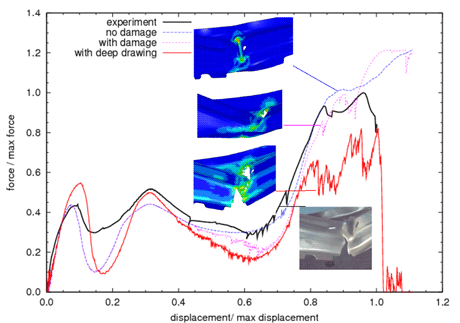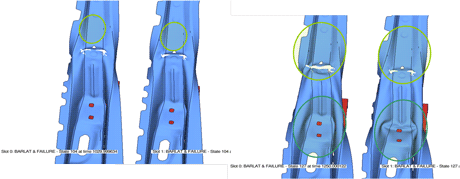Tanja Clees and Daniela Steffes-lai
Among the results of the Fraunhofer project CAROD (Computer-Aided Robust Design) is a novel strategy for the statistical analysis and multi-objective robust design-parameter optimization of chains of production processes. This strategy, PRO-CHAIN, is built upon several software tools that allow for an efficient sensitivity, stability and robustness analysis, even for simulation results on highly resolved grids. Within CAROD, concrete results have been obtained for a highly crash-relevant part of a car. In this case, the strategy also includes new material and damage models and comprises both physical experiments and numerical simulations.
Important material and process parameters, geometry and also external influences can vary considerably during the fabrication of products. These variations can have a substantial and even critical influence on the robustness of production processes and the quality of the resulting products. Analysing how variations influence processes and possibly minimizing them belongs to the most challenging research and development tasks today.
This is especially true for the consideration of whole process chains. Considerably better forecasting quality of numerical simulations can be achieved by including the history of the process in the analysis of the last process step, which is still commonly considered separately. Exemplary applications in automotive engineering are the ‘forming to crash’ and ‘casting to crash’ process chains (both considering first the process of building up a part of a car, then the process of crashing the part), and in semiconductor simulation the ‘process to device to circuit simulation’ process chains.
A novel strategy and accompanying software tools (DesParO, DIFF-CRASH) have been developed for the statistical analysis of stability, sensitivity and robustness as well as multi-objective robust design-parameter optimization of process chains. The strategy consists of the following analysis steps:
- process step 1 (eg forming)
- stability analysis of the simulation model [optional]
- parameter sensitivity analysis and efficient reduction of the design space: a small number of design points comprises the first ‘design-of-experiment’ (DoE) which can be iteratively extended if necessary in order to handle nonlinearities efficiently
- robustness analysis or multi-objective robust optimization [optional] - transfer
- preparation and compression of the database
- mapping (interpolation/restriction of functionals on grids) - process step 2 (eg crash)
- stability analysis of the simulation model [optional]
- parameter sensitivity analysis and efficient reduction of design space
- robustness analysis or multi-objective robust optimization of the whole chain.
The software tools can handle huge databases efficiently, even on highly resolved grids. Large random fields are therefore directly analysed, which is a prerequisite: highly resolved simulation grids are used per step of the process chain; additionally, data must be transferred (interpolated/restricted) from step to step.

Figure 1: Physical experiment and simulations in comparison.
During CAROD, the Fraunhofer institutes IWM and SCAI worked together on analysing the ‘forming to crash’ process chain for an exemplary real B-pillar, in general a highly decisive part for the crash safety in case of a side impact. More precisely, the largest out of four blanks of the B-pillar was considered. It consisted of micro-alloyed steel (ZStE340). The process of forming the sheet starting from a plain blank and a subsequent crash experiment for the formed blank were analysed in detail. Here, the database for the analysis comprises not only forming/crash simulation results for thicknesses and plastic strains, as is commonly the case, but also damage information. Including the latter turned out to be a crucial point. The database could be reduced to 10% of its original size (on top of ‘per-result’ compression!) without losing important information. Comparisons of experiments with simulation results (see Figure 1) clearly show the advantages of SCAI’s PRO-CHAIN together with IWM’s experimental facilities and the novel so-called BI-FAILURE damage model: a considerably increased forecasting quality of numerical simulation is obtained by considering damage information from the forming step as well as variations of thicknesses, strains and damages caused by parameter variations. In particular, PRO-CHAIN allowed an intense nonlinear interplay between a crack and a kink (see Figure 2) to be detected and its relationship to parameter variations characterized.

Figure 2: Interplay of crack with kink in an early (left) and later (right) time step. Shown are extreme simulation results, caused by parameter variations.
Links:
http://www.carod.fraunhofer.de (Web site of the Fraunhofer project)
http://www.scai.fraunhofer.de/robust-design (including links to DesParO and DIFF-CRASH)
Please contact:
Tanja Clees
Fraunhofer Institute for Algorithms and Scientific Computing (SCAI), Germany
Tel: +49 2241 14 2983
E-mail:










